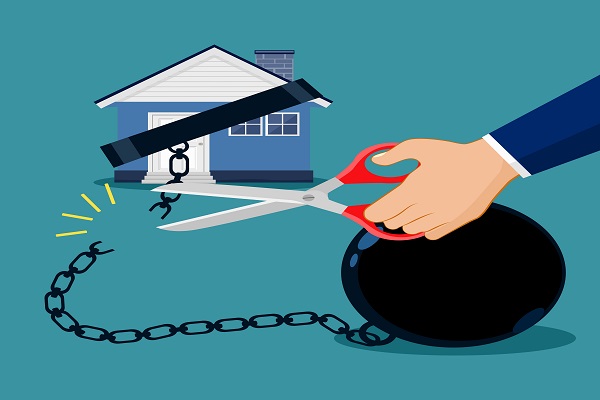News
The Pros and Cons of a Home Equity Loan
Increasingly, UK homeowners are turning to home equity loans to tap into the cash they have tied up in their properties. As average house prices continue to skyrocket, people are finding themselves sitting on small fortunes and taking full advantage of them.
With a home equity loan, it is possible to release as much as 85% of the equity you have tied up in your home. This means that if you have a home with a market value of £400,000 and you have repaid £200,000 on your mortgage, you could borrow as much as £170,000.
Essentially, a home equity loan works similarly to a second mortgage. You can borrow anything from £10,000 up to the maximum LTV (loan to value) the lender will offer, usually capped at 85%. Best of all, the funds can be used for almost any legal purpose, with almost no restrictions whatsoever.
How does repayment work with a home equity loan?
Addressing the obvious elephant in the room, your home may be at risk of repossession if you do not keep up with your equity loan repayments. Paying back a home equity loan works in the same way as a mortgage, an ongoing series of monthly repayments, as agreed with your lender.
Unlike a mortgage, there are no deposit requirements to take out the loan, and the facility can be arranged much faster.
Interest rates and borrowing costs vary significantly from one lender to the next, highlighting the importance of shopping around for a good deal.
What are the advantages of home equity loans?
The biggest benefits of taking out a home equity loan are as follows:
- Access a large amount of credit: For eligible homeowners, home equity loans provide the opportunity to access significant amounts of tied-up capital. You may be able to borrow up to 85% of the equity you have tied up in your home, far more than any personal loan or unsecured product.
- Lower interest rates: Loans secured against assets of value almost always have lower rates of interest than comparable unsecured products. The provision of assets as security for the loan makes it a lower-risk facility in the eyes of the lender.
- Longer repayment terms: Repayment terms on a home equity loan are flexible and can be tailored to suit the requirements of the borrower. Depending on how much you borrow, you could repay the loan gradually over anything from five to 35 years.
- Wide range of uses: Most lenders place comparatively few restrictions on how a home equity loan can be used. From home improvements to investment property purchases to funding new business start-ups, the funds are yours to do anything you want with.
What are the disadvantages of home equity loans?
Before applying for a home equity loan, it is important to consider the following drawbacks:
- Risk of repossession: If you fall behind on your repayments, your lender may begin repossession proceedings and seek to take ownership of your home. It is therefore inadvisable to apply for any kind of secured loan unless you are 100% confident in your ability to repay the facility in full.
- Long-term debt: The decision to enter any form of long-term debt should not be taken lightly. This counts double if you are still repaying your original mortgage, and you will subsequently find yourself with two equally important monthly outgoings to cover.
- Additional fees and costs: Depending on whom you work with, arranging a home equity loan can be anything from highly affordable to extremely expensive. Arrangement fees, valuation fees, administration fees, broker fees, and exit fees may all apply, so it is important to shop around for a good deal.
Can I repay a home equity loan early?
If you change your mind and decide to repay your home equity loan early, you are perfectly within your rights to do so. However, the vast majority of lenders impose early repayment fees in order to compensate for lost interest.
This is something to be particularly mindful of when formalising your agreement. Early repayment fees vary significantly between products and lenders and should be considered carefully before taking out any secured loan.
How to Boost Your Chance of Being Granted Planning Permission
Planning permission rejections are anything but uncommon. In fact, around 25% of all planning permission applications submitted in England are unsuccessful.
When a request for planning permission is rejected, it can lead to major disruptions and potential financial losses. Submitting repeat applications is an option, but it is far from the most desirable course of action.
Irrespective of the type of project you are planning, the same basic rules must be followed to give your application the best possible chance of being accepted. Understanding the most common reasons planning permission is denied is a good place to start, as most declined applications fail for the same basic reasons.
A few examples include the following:
- Use of hazardous or prohibited materials.
- Overlooking other people’s properties.
- Modifications that would block a neighbour’s natural light.
- Potential impact on trees, nature, and habitat.
- not keeping in with the character of the area.
Conducting adequate preparation when planning an application means understanding and anticipating these potential issues. All aspects of your proposal must be presented in a way that shows you have considered all applicable regulations.
Enlisting expert help at an early stage could also prove invaluable. For example, if you are seeking third-party funding for an extensive project, your provider and/or broker may be able to help with your planning permission application.
In some instances, applications submitted by (or with the support of) a skilled third party carry more weight. The same can be said for those who carry the support or recommendation of a reputable surveyor.
But irrespective of whether you plan on going it alone or seeking outside help, there are four important things you need to do to ensure your application is successful:
- Make sure you provide all the required information the first time: With each declined planning permission application, your likelihood of success the next time around decreases. You, therefore, need to ensure that you have all the required information and documentation in place the first time.
To submit an application for any kind of project, the following will be needed:
- Five copies of the application form.
- A signed ownership certificate.
- A Design and Access Statement.
- The planning permission fee.
- A site plan, which shows the planned changes in detail.
- A block plan that shows the location of the site in the local area.
- Elevations of the proposed site.
Be mindful of the fact that if any documentation is absent or incomplete, the application as a whole will be rejected.
It is advised that you:
- Provide detailed building models: If possible, accompany your planning permission application with a detailed digital model of your proposed building (or modification). BIM models can be great for showing how the finished project will look in its surroundings and whether it will comply with all applicable regulations.
- Demonstrate your understanding of the rules: Your job is to convince the local council that you have considered and carefully considered all applicable rules and requirements. From accessibility to sustainability to health and safety, a demonstration of compliance and understanding holds the key to a successful application.
- Provide evidence of due diligence: Finally, you can also boost the chances of the application being successful if you provide robust evidence of due diligence. This means showing that you have conducted extensive research into how your project will comply with all local and national regulations. For example, you could accompany your application with an architect’s drawing, providing a clear indication of how your project will fit in with its surroundings.
New Study Highlights Landlords’ Confidence in the UK’s Booming BTL Sector
In the face of an unprecedented living cost crisis and a looming economic downturn, the UK’s housing sector continues to go from strength to strength. New figures released by Handelsbanken indicate unwavering optimism in both residential and commercial property among investors looking to capitalise on skyrocketing demand for affordable homes and business units.
The figures from Handelsbanken suggest that almost 50% of professional landlords (those with a minimum of four properties in their portfolios) plan to invest in one or more properties over the next 12 months. Meanwhile, 35% said they would hold their portfolios at their current levels, while just 7% indicated their intention to liquidate one or more of their assets.
Handelsbanken’s first SME Landlord Survey also revealed that more than 85% of landlords are anticipating an increase in demand for residential property rentals over the coming year. Commercial property landlords also indicated optimism for the year ahead, with 63% predicting an increase in demand for commercial units.
Interestingly, 89% of the landlords who took part in the poll said they expect average rental yields to decrease slightly within the next 12 months.
Diversification is a priority for many landlords
73% of landlords indicated their intent to diversify their property portfolios going forward. Houses remain the biggest draw for landlords planning property purchases (66%), followed by 38% who plan to buy flats, 34% setting their sights on houses of multiple occupations, and 32% planning to purchase commercial retail units.
Meanwhile, London continues to gain the lion’s share of attention from landlords planning to diversify their portfolios. 53% said they intend to buy properties in and around London, followed by 40% looking to buy into the East of England, and 22% who see the East Midlands as the most attractive location to purchase new properties.
A resilient and buoyant market
Speaking on behalf of Handelsbanken, chief economist James Sproule highlighted how even the escalating living-cost crisis is having no major impact on the buoyancy of the UK property market.
“Recent house price growth shows how property has shown its resilience against economic doom and gloom and the cost-of-living squeeze,” he said.
“Landlords are anticipating that a shortage of rental properties will help keep prices buoyant, particularly as working patterns continue to adjust to the post-pandemic world and people seek to move back to big cities, particularly in popular areas such as London, which is also seen to be better placed to ride out the next series of economic challenges and opportunities.”
“Landlords went through a tough period following the COVID-19 pandemic, with residential property transactions falling by more than half and business investment contracting. But the sector has survived and is now looking forward.”
“The 2022–23 financial year is forecast to see a further softening in residential property transactions as vendors wait for the right buyer rather than accept any perception of loss in value.”
Buy-to-let investments boom
The figures suggest that, far from a decline, the withdrawal of the stamp duty holiday and lingering economic uncertainty have actually triggered a major spike in buy-to-let investment interest. Buy-to-let remains an attractive option for newcomers and established investors alike, due to the near certainty of generous rent yields and sky-high capital gains.
This is particularly true in and around London, where the latest Zoopla Rental Index pins the average monthly rent at a huge £1,698. That is more than 15% higher than the same time last year and is expected to continue climbing.
Remote and hybrid working models are sustaining high levels of demand for rental properties with private gardens and for those in proximity to public parks. While this continues as the new norm, investors will continue to set their sights on homework-friendly homes as uniquely attractive investment opportunities.
How to Fund Your Farming Business with Bridging Finance
So you have dreamt about starting your own farming business but don’t know where to start. Today we will be looking at how to get started, the pros and cons, and most importantly, what kind of funding is available to you.
Running a farm is not an easy prospect, and it is vital that you understand exactly what you are taking on before you start the process.
Important things to consider when starting a farm
Before you start, you must decide on what kind of farm you will be starting, which will be determined by aspects such as weather and location. You will need to be realistic about your options and budget so that you can be sure that you have taken all financial implications into account, such as technological investments, employee costs, repairs, and maintenance, amongst others.
Demand for what you are farming should be carefully considered, and it is vital that there is a market for your produce for your farm to be successful. While the idea of farming may seem like an attractive option, there are many eventualities that could lead to disaster, including floods, droughts, market price crashes, operating cost increases, and poor crop yields, to name but a few. Investing in effective irrigation systems and water tanks can go a long way towards tackling some of these issues; however, that comes at a price that will need to be factored into the overall cost when looking for funding for your new farm business.
If you are planning to farm livestock, you will need to have a good veterinarian with plenty of experience with farm animals. Waste management for livestock farming is also of paramount importance, and you will need to stay on top of it. Manure can be collected and used as fertiliser or sold for profit.
The next important thing to consider is what technology will be required for the type of farming you plan to do. Technology may include, but is not limited to, machinery, tools, specialist software, and livestock tracking devices. It is vital to keep all software up-to-date in order to get the best out of the technology you will be utilising. It is worth investing in items that will prolong the life of your machinery, such as rain covers and sheds.
Knowing your crop well and when to plant is absolutely imperative to being a successful farmer. It is also advisable to rotate your crops, as planting the same crop year after year can result in pest and disease issues. Soil conservation is just as important, so efficient soil testing will be essential.
Advantages and disadvantages of managing your own farm
While starting a farm may be the perfect choice for you, it is worth looking at the pros and cons, as running a successful farm can be a lot harder than you may imagine.
Advantages
If you do your research on consumer demand before deciding whether you are going to invest in livestock or agricultural farming, you will be halfway to a profitable future. The demand for farm produce, whether it be fruit, vegetables, meat, or wool, will always be there, making it a potentially very lucrative endeavour. Pricing things correctly will, of course, be the key to success, as will looking at your competition and marketing yourself and your products effectively.
The opportunity to diversify is also a big advantage when it comes to farming. You will not need to stick to one type of crop or livestock and can mix both if you wish to. Other forms of income can also be looked at, such as a petting zoo or a bed and breakfast. These opportunities can potentially generate some further income for you.
Another advantage is the sense of achievement you will experience when farming in a way that gives back to the environment and the local area. You will reap health benefits from being outdoors, and as farming is quite a physical job, it will go a long way towards keeping you fit and in shape.
Disadvantages
As there is always a downside to nearly everything, it is advisable to consider these before taking the leap into farming.
One of the main cons is that you will, at some point or another, have to cope with extreme weather. If the great outdoors is not for you, then it is probably safe to say that neither is the life of a farmer. Early starts, around 5 a.m., are typical, so if you are not a morning person, then this is not the career for you.
Harsh weather is not only hard for the farmer but can be detrimental to crops, particularly in the winter months. Strong winds, snow, and rain can ruin crops, especially when it is not the typical weather for the season. With global warming causing unpredictable weather such as extremely high temperatures, droughts, and floods, it can be difficult to predict what lies ahead. High winds can also damage farm property, such as fences and buildings.
Farming is also extremely hard work and is not for the fainthearted. Twelve-hour days are typical, and time off can be difficult as farm duties don’t stop. You will need to be physically fit and mentally strong to work in this industry. Hiring staff will alleviate these issues so that you can take a break at times.
Financing your farm with an agricultural bridging loan
Once you have done your homework and decided that managing a farm is perfect for you, you will need to work out what funding you will need to get started.
Agricultural bridging finance is available for those looking to start a farming business and is designed to provide short-term funding, typically between 1 month and 3 years. As it is a secured loan, the amount you can borrow will depend on the value of the assets you offer as collateral.
There are many uses for an agricultural bridging loan, including quick land purchases. As bridging finance can be arranged faster than other types of loans, it is an attractive option for those looking to buy quickly, particularly if you find a fantastic deal that requires you to act fast in order to secure the land.
Short-term funding, such as bridging finance, can also be used to purchase expensive agricultural machinery such as tractors, harvesters, feeding systems, etc.
Agricultural bridging loans can also be used for farmers wishing to diversify and move into other areas, for example, a zoo or café, which can be very costly but can be funded with short-term finance.
As farming can be somewhat risky due to weather and other external factors, sometimes funds are required to repair, recover, and restructure when there have been unexpected issues. Due to the speed at which an agricultural loan can be arranged, you will be able to get things back on track faster than if you were to take out a more traditional loan product, which will take significantly longer to arrange.
For livestock farmers, existing livestock, which is considered a tangible asset, can be used as security in order to secure a bridging loan to buy more. This gives you the opportunity to expand the business and increase profitability. Agricultural bridging finance is used by farmers a lot due to the ever-changing and often unexpected changes that occur in this industry when funding is needed fast until longer-term loans can be arranged. For this purpose, this type of loan product is the best solution; however, it is imperative that you consult with a specialist broker who is experienced in this area and can give you all the advice you need and help you secure the best deal.
Funding A Property Purchase for a Family Member
Bridging finance specialists across the UK have noted an uptick in applications from parents looking to help get their kids on the property ladder. Not that this is particularly surprising when considering the unprecedented difficulties being faced by first-time buyers.
In May, the average house price in the UK hit another record high of £289,099. This represents an increase of more than £2,850 from the previous month or 1%. House prices have now soared to record highs for 11 consecutive months and are up an astonishing 10.5% from the same time last year.
The likelihood of house prices falling over the coming months is minimal, but there are at least signs of a modest slowdown in house price acceleration.
“Yes, prices have still risen 1 per cent on the month, marking the eleventh successive monthly increase, and yes, prices are up by 10.5 per cent on the year, keeping annual price growth in double digits, but this is the slowest rate of growth since the start of the year and shows the challenges ahead cannot be ignored,” commented Alice Haine, Personal Finance Analyst at investment platform Best Invest.
“With mortgage rates surging, following four consecutive interest rate rises from the Bank of England since December and further hikes expected this year, and inflation of 9 per cent eating into real incomes, it is only natural that prospective buyers may take a pause before plunging into the market right now.
“Add in the cost-of-living crisis and the fact fuel prices are now at record highs [petrol prices set a new average record of 178.5p per litre on Tuesday], and the cost of buying a home may deter those already struggling to meet their monthly obligations.”
Insurmountable costs for first-time buyers
Speaking on behalf of Halifax, managing director Russell Galley highlighted how impossibly expensive it is becoming to buy property in the UK.
“For house hunters, the extent of the impact of property price inflation continues to be linked to the type of home they are looking to buy,” he said.
“Compared to May last year, you would need around £10,000 more to buy a flat, but an additional £50,000 for a detached home.”
“This clearly creates a knock-on effect for those looking to make their first home move, as the rungs on the housing ladder have become increasingly wide.”
For first-time buyers, pulling together a ten per cent deposit for an average UK home now means saving at least £30,000. Where lenders insist on 15% or 20% deposits, the figure could be as high as £60,000.
Even last year, when average house prices were lower than today, data from Barclays indicates that the average deposit paid by a sole first-time buyer was £61,100.
This is the kind of money the typical first-time buyer simply cannot come up with. Faced with an escalated cost-of-living crisis, the dream of homeownership for millions of prospective buyers is likely to remain just that.
House prices are up a staggering £123,016 (or 74%) over the past decade, during which wages for many have stagnated.
Tomer Aboody, director of property lender MT Finance, said: “With prices rising by 74% in the past decade, it shows just how much the market is running away from first-time buyers,” commented Tomer Aboody, director of property lender MT Finance.
The bank of mom and dad
Traditionally, parents looking to help their children get on the property ladder have provided financial support in the form of a contribution to their deposit. With deposit requirements at an all-time high, many first-time buyers are finding this the only realistic way to qualify for a mortgage.
Elsewhere, first-time buyers (and their families) are setting their sights on properties away from the conventional housing market. With affordability and accessibility in mind, many are looking to purchase properties in need of renovations and repairs with the aim of gradually moulding them into their dream homes.
This approach has generally proved problematic for first-time buyers seeking funding from mainstream lenders. The vast majority of High Street banks are unwilling to lend against properties in a poor state of repair, which are often categorised as ‘not mortgageable’.
For example, if a property lacks a functional kitchen or a working indoor bathroom, it may be completely out of the running for a conventional mortgage.
This is where bridging finance is proving to be a lifeline for first-time buyers across the country. Bridging loans differ from conventional home loans in that they can be used to purchase any type of property in any state of repair. They are also designed to be repaid as promptly as possible, usually within 1 to 18 months of being issued.
How bridging finance is helping first-time buyers
To understand how parents are using bridging finance to help their children buy their first homes, consider the following everyday example:
- A property is set to go under the hammer at auction for considerably less than its true market value, as it requires considerable repairs and renovations to bring it up to a liveable standard.
- The parents of the first-time buyer take out a bridging loan, using their own home as security for the facility. Bridging finance can be arranged within just a few working days, making it ideal for time-critical home purchases and investment opportunities.
- A bridging loan is provided to cover the full costs of the property and those of the subsequent renovations. The property is purchased at the auction, payment is made in full, and the new owners begin the renovations.
- Several months later, the property has been brought up to an excellent standard and is no longer classified as not mortgageable. The property is remortgaged onto a longer-term repayment facility (like a conventional mortgage), and the bridging loan is repaid.
- In the meantime, the bridging loan will be charged at a rate as low as 0.5% per month, making it a hugely cost-effective product when repaid promptly.
What is important to note about this approach to purchasing a home are three things:
- There is no need to come up with any kind of deposit whatsoever, as no deposit is payable on a bridging loan. This means first-time buyers (with the assistance of their parents) with limited on-hand savings need not be counted out of the running.
- Bridging finance opens the door to the kinds of property purchases that would be out of the question with a conventional mortgage. Particularly when it comes to fixer-upper homes in questionable condition, traditional mortgages are typically unavailable.
- Prompt repayment of a bridging loan can make the transaction in its entirety so much more affordable than arranging any conventional loan or mortgage. Monthly interest can be as low as 0.5%, and all other associated borrowing costs are negligible.
Given the estimated 200,000 properties in England that have stood unoccupied for six months or more, bargain hunters are advised to extend their search beyond the conventional property market.
Flexible finance for homeowners
Bridging finance is also a significantly more flexible and accommodating facility than any conventional mortgage. This can be particularly useful for applicants who are unable to provide formal proof of income or may have imperfections on their credit file.
Likewise, homeowners who are retired and would likely be turned down by high-street banks are also eligible for bridging finance.
Qualification criteria for bridging finance are not nearly as strict as conventional mortgage eligibility checks.
Bridging loans are issued on the basis of the following:
- Ownership of assets of sufficient value to cover the costs of the loan, i.e., the property of the applicant.
- Evidence of a workable exit strategy in reference to how and when the loan will be repaid by the borrower
A good credit score and evidence of a stable financial position will pave the way for a more competitive product. But even with poor credit, no proof of income, and a history of bankruptcy, it is still perfectly possible to qualify for bridging finance.
Consult with an experienced broker
If you are considering taking out a bridging loan to help a member of your family get on the property ladder, independent broker support is highly recommended.
Bridging finance is issued in a variety of forms with different purposes in mind, so it is important to know which type of bridging loan is right for you. Your broker will also be able to advise on the alternative financial products available if there is something that could prove more cost-effective than a bridging loan.
Your broker will negotiate on your behalf to ensure you get an unbeatable deal from a top-rated lender. Many of the UK’s leading bridging specialists offer their services exclusively by way of broker introductions and do not deal with customers directly.
For more information on any of the above or to discuss the potential benefits of bridging finance in more detail, contact a member of the team at UK Property Finance today.
What’s Happening in the BL Market (and Why Borrowers Are Reaping the Benefits)
As if the UK’s economic picture wasn’t already sketchy enough, its future outlook is even gloomier. The cost-of-living crisis is likely to worsen before it improves, with the Bank of England warning that inflation could go beyond 10% before the year is out.
But there is at least one positive in all the doom and gloom, at least from a bridging finance perspective; while all this is going on, the bridging loans sector is not only booming but is also offering its most competitive products in history to a growing audience of borrowers.
Application volumes and inquiry levels continue to hover at unprecedented highs as businesses and consumers alike take their businesses away from the major High Street banks. The more difficult and expensive it becomes to qualify for conventional loans or mortgages, the greater the tendency to seek unconventional alternative options.
One of which is bridging finance, which, due to its speed, flexibility, and accessibility, has skyrocketed in popularity over the past couple of years.
“This is great news, of course, particularly in the challenging economic environment,” said Vic Jannels, chief executive at The Association of Short-Term Lenders (ASTL).
“The latest ASTL lending data for the final three months of last year has revealed that completions were £1.2m for the quarter, which represents a record high and an increase of 19% on the previous quarter. This has led to another increase in loan books, which now stand at £5.08bn,” added Jannels.
Housing market competition: A key driver
Gross bridging loan completions were up a full 32% (reaching £485 million) during the first six months of last year, increasing further to an impressive 52% by November. This momentum has been largely maintained throughout 2022, resulting in average bridging loan interest rates hitting a new all-time low.
All of which is playing right into the hands of prospective homebuyers, many of whom are becoming increasingly disenchanted with what is available on the High Street, if not entirely out of the running for mortgage loans, due to increasingly strict lending criteria.
Demand for affordable homes continues to outstrip supply in almost every part of the UK. For buyers looking to avoid regrettable chain-break scenarios, bridging finance is offering a fast-access lifeline. Secured against their current home, a bridging loan can be used to buy their next home outright and allow plenty of time to sell their previous home for its full market value.
In addition, property developers are turning to bridging finance to fund purchases and renovations of vacant properties across the country. As most major banks continue to classify homes in questionable condition as ‘not mortgageable’, developers are finding themselves with little choice but to explore the alternative options available.
Matthew Arena, managing director at Brilliant Solutions, believes that the bridging finance sector is playing a major role in easing at least some of the pressure the housing sector is under.
“Bridging is performing well and has helped with several key housing issues,” he said.
“With property supply being so scarce, the ability of investors to develop or refurbish property and sell quickly is driving the sector,”
“Equally, the regulated element of the business is growing as the drive to move is as high as ever and suitable property is so difficult to find.”
“This is leading to more refurbishment and also a higher tendency to pay for bridging as a chain-break solution because there is a greater certainty of sale and a higher perceived loss if the opportunity falls through.”
Competitive finance with flexible terms
Unsurprisingly, demand for fast-access bridging finance has triggered a major spike in product availability from a growing network of specialist lenders. Once a fairly niche field, the bridging sector has become fiercely competitive.
Covering the needs of consumers and businesses alike, there are so many lenders now fighting to get new customers on board that average interest rates have been plummeting. It is now the norm to be offered a bridging loan with a monthly interest rate in the region of 0.5% or less, having once been reserved exclusively for prestige clients.
Meanwhile, associated borrowing costs (arrangement fees, transaction fees, completion fees, etc.) have likewise been dropping for some time, if not being removed entirely by many bridging specialists.
Alongside increasingly competitive deals, the flexibility of bridging finance is also proving a big draw for prospective borrowers. Employment status, proof of income, financial position, credit score, none of the usual obstacles apply to bridging finance applications.
Bridging loans are issued primarily based on two things: the provision of assets of value to cover the costs of the loan and evidence of a viable exit strategy for timely repayment. No jumping through hoops and no need to disclose your entire life story, as remains the case on the High Street.
All of which paints a picture of a booming bridging finance sector that’s becoming increasingly attractive to borrowers from all backgrounds. And with more economic doom and gloom on the horizon, it is a trend that looks set to continue for some time to come.
Opportunities of Bridging Loans and How They Can Support Chain-Free Home Purchases
The UK’s housing market continues to go from strength to strength, proving a blessing for some and a curse for others. Disparities between supply and demand are growing, with the average estate agents’ branch now having just 22 properties available for purchase.
By contrast, estate agents currently have an average of 84 registered buyers, prompting ferocious competition among interested bidders.
Meanwhile, the number of cash buyers purchasing homes outright has increased significantly. According to the latest data published by Hamptons, a full 73% of home purchases in 2022 so far took place ‘chain free’. Back in 2010, the figure stood at just 65% when becoming part of a property chain was not seen as such a risk.
Commenting on the findings, Hamptons said that the more competitive things become on the housing market, the greater the appeal of becoming a cash buyer. Traditionally, the ability to purchase a home outright has been reserved for those with significant on-hand cash reserves.
The appeal of chain-breaking
The biggest benefit of avoiding conventional property chains is removing reliance on other buyers and sellers. If you have the cash available to purchase your next home outright, it doesn’t matter whether you have found the right buyer for your home.
You can purchase your next home for cash, leave your previous home on the market and wait for it to sell for its full market value. The opposite is to move only after agreeing on a sale on your current home, which means becoming part of a long and potentially fragile property chain.
In addition, estate agents report that properties purchased chain-free are almost always offered at preferential rates. On average, it can cost around 2.5% less to purchase a property as a cash buyer, than via conventional channels.
It is therefore understandable why more prospective movers than ever before are looking into the available options for going chain-free. One of which is bridging finance, opening the possibility of cash property purchases up to a much broader audience.
Bridging finance for chain-free home purchases
A competitive bridging loan can empower movers with the flexibility traditionally enjoyed only by comparatively wealthy cash buyers. The simple fact of the matter is that most homebuyers simply do not have massive sums of cash in reserve, sufficient to purchase their next property outright.
Bridging finance is issued in the form of a secured loan, similar to a mortgage. The applicant’s home is used as security for the loan and the amount they can borrow is based on their equity level.
For example, a homeowner with a property valued at £400,000 could take out a £300,000 bridging loan with an LTV of 80%. If the same homeowner had only paid off 50% of their mortgage, they would have £200,000 equity and could therefore borrow £150,000 at 80% LTV.
Importantly, the funds raised with a bridging loan can be accessed much faster than those associated with a conventional mortgage or home loan. With all the required paperwork and evidence in place, the facility can be arranged and accessed in just a few working days.
This gives prospective buyers with sufficient equity in their current home the opportunity to buy their next home outright, beating competing bidders to the punch.
Cost-effective property purchase loans
As mentioned above, vendors are often willing to accept lower prices for their properties from chain-free bidders, typically around 2.5%. In addition, relocating with bridging finance negates the need to rush through the sale of your own home and perhaps agree to a price you are not fully happy with.
After buying a new home with a bridging loan, the buyer’s previous home can be left on the market for as long as it takes to sell it for the best possible price. In the meantime, interest accrues at a rate as low as 0.5%, adding up to a hugely cost-effective facility.
Best of all, the flexibility of bridging finance opens competitive short-term funding up to the broadest possible audience. Even with a poor credit rating or a history of bankruptcy, it is still possible to qualify for a competitive deal.
For more information on the benefits of buying a home chain-free or to discuss any aspect of bridging finance in more detail, contact a member of the team at UK Property Finance today.
Mixed-Use Properties Enters Top Five Commercial Broker Searches, But What is a Mixed-Use Property?
Knowledge Bank’s latest round-up of commercial product search terms makes for interesting reading, as ‘mixed-use properties that are part commercial’ enters the top five for the first time since January. No movement was noted in the top three search terms for May, with semi-commercial ‘properties’, ‘maximum TV’, ‘maximum LTV’ and ‘minimum loan amount’ topping the table once again.
Meanwhile, there was no major movement whatsoever in the top three broker searchers within the bridging sector for May. Identical to April, the top searches for the month came out as regulated ‘bridging’, ‘minimum loan amount’, and maximum LTV’.
Over in the BTL arena, the top three search terms were ‘first-time landlords’, followed closely by ‘lending to limited companies’ requirement to be a homeowner’. All of them featured in the top five in April, having held their positions consistently for some time.
What is a mixed-use property?
New and established investors across the UK are increasingly setting their sights on mixed-use properties. By definition, a mixed-use property is a property that occupies two or more ‘use classes’ over different stories or areas of the structure.
For example, one of the most common mixed-use properties is a building that occupies one or more flats in its upper areas and a shop or commercial unit of some kind on the ground floor. Larger developments that comprise homes, offices, and commercial spaces in any number are also considered mixed-use properties.
The vast majority of mixed-use properties feature a vertical configuration, wherein residential units occupy certain floors and commercial/business units are based on other floors. There are exceptions to the rule where residential and commercial units may be configured horizontally, but this tends to be less commonplace.
What are the benefits of mixed-use properties?
From a resident’s perspective, living on a mixed-use property can be advantageous in many ways. Some people appreciate the proximity of their home to the amenities within the property, which could be anything from a supermarket to a gym to a bar or restaurant.
In addition, mixed-use properties are usually situated in fairly central locations and are likely to have excellent public transportation links. For those renting or buying commercial space in a mixed-use property, there is typically the benefit of high footfall in a busy urban centre.
From the investor’s viewpoint, mixed-use properties have the potential to combine the best of all worlds. Where an investor owns the property in its entirety, they can bring in potentially high rents from residential occupants and commercial tenants alike.
Savings can also be made on tax obligations, as buying a mixed-use property typically means paying stamp duty for the structure as a 100% commercial property. This can be cheaper than paying the equivalent stamp duty for a solely residential property, making for an attractive investment opportunity.
Specialist funding
Perhaps the only downside to mixed-use property investments is the lack of specialist products available on the High Street. A standard buy-to-let mortgage from a major lender cannot be used to buy a mixed-use property, and many lenders do not issue loans or mortgages for these kinds of properties at all.
Investors must therefore consider the options available away from the High Street’s biggest banks and lenders. The UK’s independent lending sector is typically a more accessible and cost-effective option for mixed-use property purchases, with a wide variety of options available.
Examples of these include bridging finance, specialist development finance, commercial buy-to-let loans, and other types of secured business loans.
For more information on any of the above or to discuss mixed-use property finance in more detail, contact a member of the team at UK Property Finance today.




 0116 402 7982
0116 402 7982







